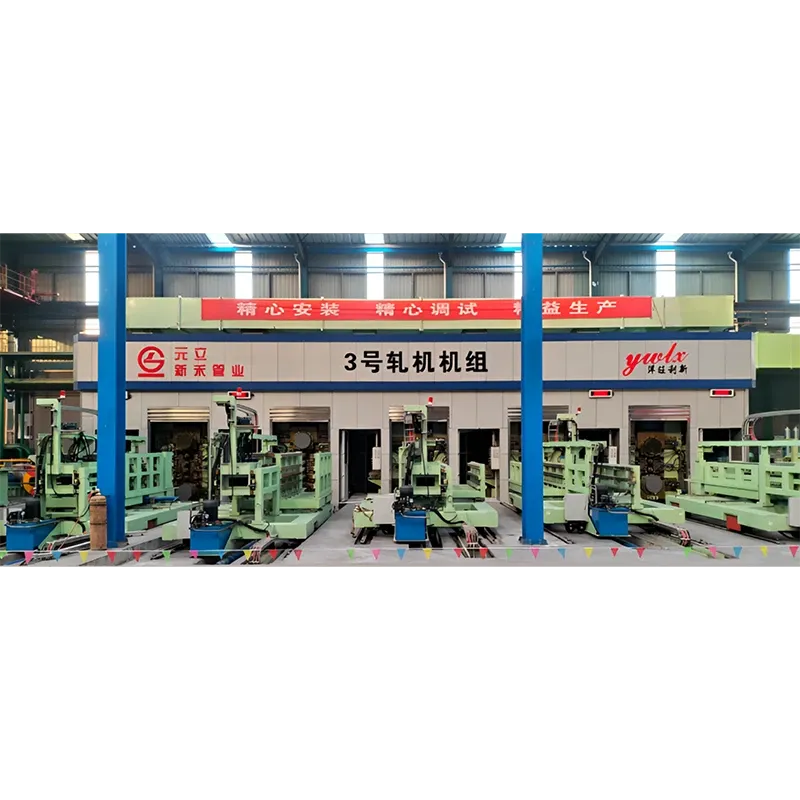
The Role of Tandem Cold Mill in the Production of High-Strength Steel for EV Components
The electric vehicle (EV) revolution is driving unprecedented demand for advanced steel grades that combine lightweight properties with exceptional strength. To meet these requirements, manufacturers rely on the tandem cold mill, a high-precision rolling system capable of producing ultra-thin, high-strength steel coils with tight tolerances. The tandem cold mill process is particularly crucial in forming materials used in EV battery enclosures, motor housings, and structural reinforcements, where weight reduction without compromising durability is essential.

The Pickle Line Tandem Cold Mill: Preparing Steel for High-Strength Applications
Before steel can undergo cold reduction, it must first be cleaned of oxides and scale formed during hot rolling. This is where the pickle line tandem cold mill configuration plays a pivotal role. The pickling line uses hydrochloric or sulfuric acid to dissolve surface impurities, ensuring a smooth, defect-free substrate for subsequent rolling.
In modern production lines, the pickling line and tandem cold mill operate as a continuous system, minimizing handling and improving efficiency. The pickled coil is fed directly into the tandem rolling mill, where it undergoes progressive thickness reduction. This seamless transition is critical for maintaining material integrity, as any delays between pickling and cold rolling could lead to re-oxidation or contamination.
For EV-grade steel, the cleanliness and uniformity achieved by the pickle line tandem cold mill are especially important. Even minor surface defects can compromise the performance of safety-critical components, making the integration of these processes indispensable.
The Tandem Cold Mill Process: Achieving Precision and Strength
The tandem cold mill process involves passing the steel strip through a series of rolling stands—typically four to seven—each applying controlled pressure to reduce thickness incrementally. Unlike single-stand mills, the tandem rolling mill ensures continuous deformation, resulting in superior mechanical properties and dimensional accuracy.
Key Stages in the Tandem Rolling Mill Process
Initial Reduction (Entry Stands):
The first few stands apply significant thickness reduction, transforming the pickled hot-rolled coil into a thinner intermediate product.
Intermediate Rolling (Tension Control):
Subsequent stands refine the strip’s gauge while maintaining precise tension to prevent warping or edge cracking.
Final Pass (Finishing Stands):
The last stand ensures the exact thickness and surface finish required for high-strength EV applications.
One of the most critical aspects of the tandem mill rolling process is its ability to enhance steel strength through work hardening. By carefully controlling rolling parameters—such as reduction ratios, rolling speed, and lubrication—manufacturers can produce advanced high-strength steel (AHSS) and ultra-high-strength steel (UHSS) grades that meet the stringent demands of EV components.
Advantages of Tandem Rolling Mills for EV Steel Production
The tandem cold mill offers several advantages over traditional rolling methods, making it ideal for manufacturing EV-grade steel:
1. Superior Mechanical Properties
The progressive deformation in a tandem rolling mill enhances grain structure, resulting in improved tensile strength and formability. This is crucial for EV battery enclosures, which require both high strength and crash resistance.
2. High Production Efficiency
Unlike batch processing, the continuous nature of the tandem cold mill process allows for high-volume output with minimal downtime, meeting the automotive industry’s demand for large-scale production.
3. Tight Thickness Tolerances
EV components, particularly those used in battery systems, require ultra-precise thickness control. The tandem mill rolling system achieves tolerances as tight as ±1 micron, ensuring consistency across large coil lengths.
4. Flexibility in Material Grades
The same tandem rolling mill can process various steel grades, from dual-phase (DP) and martensitic steels to advanced TRIP (Transformation-Induced Plasticity) steels, allowing manufacturers to tailor materials for specific EV applications.
Integration of Smart Technologies in Tandem Cold Mills
To further enhance precision and efficiency, modern tandem cold mills incorporate Industry 4.0 technologies:
AI-Based Process Optimization: Machine learning algorithms analyze rolling parameters in real time, adjusting force and speed to minimize defects.
Predictive Maintenance: IoT sensors monitor equipment wear, preventing unplanned shutdowns and extending mill lifespan.
Digital Twin Simulations: Virtual models of the tandem rolling mill process allow engineers to test different rolling scenarios before physical production, reducing trial-and-error costs.
These innovations are particularly valuable in EV steel production, where material consistency is non-negotiable.
Tandem Cold Mills and Sustainable EV Manufacturing
As the automotive industry shifts toward sustainability, the tandem cold mill is evolving to support greener steel production. Emerging trends include:
Hydrogen-Based Pickling: Replacing traditional acid pickling with hydrogen-based processes to reduce environmental impact.
Energy-Efficient Rolling: Using regenerative braking systems in tandem mills to lower power consumption.
Recycled Steel Processing: Adapting tandem rolling mills to handle higher percentages of recycled steel without compromising quality.
These advancements will ensure that tandem cold mills remain at the forefront of high-strength steel production for the next generation of electric vehicles.
Tandem Cold Mills as a Cornerstone of EV Steel Manufacturing
The tandem cold mill is an indispensable technology in the production of high-strength steel for EVs. Its integration with pickling lines, continuous processing capabilities, and adoption of smart technologies make it the most efficient and precise method for manufacturing lightweight yet durable steel components.
As EV designs continue to evolve—demanding even stronger and lighter materials—the tandem rolling mill process will play an increasingly vital role. By leveraging automation, AI, and sustainable practices, manufacturers can ensure that their tandem cold mills meet the future needs of the electric vehicle industry.
-
YWLX’s 1450mm Six-Hi Reversing Mill Goes Live in BangladeshNewsNov.24,2025
-
Adjusting Roll Gap in 6Hi Reversing Cold Rolling Mill for Thin StripNewsNov.13,2025
-
Quality Control Standards for Automatic Gauge Control in Strip RollingNewsNov.13,2025
-
Effect of Skin Pass Rolling on Metal DuctilityNewsNov.13,2025
-
Key Components of a Modern TempermillNewsNov.13,2025
-
Common Wear Patterns of Work Roll in Tandem Cold Mill OperationsNewsNov.13,2025
-
Revolutionary Skin Pass Rolling Technology for Enhanced Steel QualityNewsNov.04,2025










